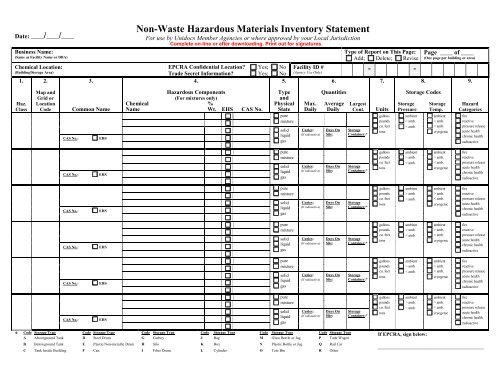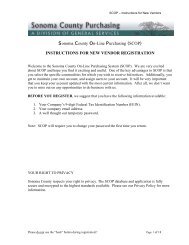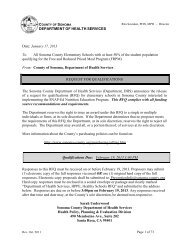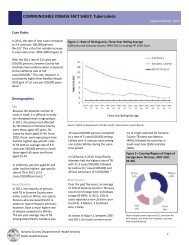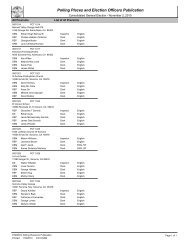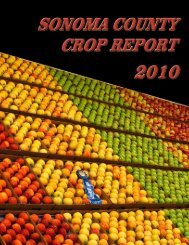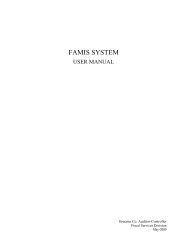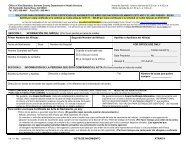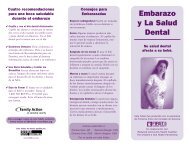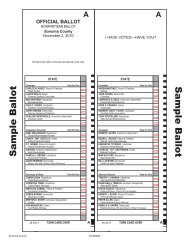Non-Waste Hazardous Materials Inventory Statement - County of ...
Non-Waste Hazardous Materials Inventory Statement - County of ...
Non-Waste Hazardous Materials Inventory Statement - County of ...
Create successful ePaper yourself
Turn your PDF publications into a flip-book with our unique Google optimized e-Paper software.
Date: ____/____/____<br />
<strong>Non</strong>-<strong>Waste</strong> <strong>Hazardous</strong> <strong>Materials</strong> <strong>Inventory</strong> <strong>Statement</strong><br />
For use by Unidocs Member Agencies or where approved by your Local Jurisdiction<br />
Business Name:<br />
(Same as Facility Name or DBA)<br />
Chemical Location:<br />
(Building/Storage Area)<br />
1. 2.<br />
3.<br />
EPCRA Confidential Location? Yes; No<br />
Trade Secret Information? Yes; No<br />
4.<br />
5.<br />
Type <strong>of</strong> Report on This Page:<br />
Add; Delete; Revise<br />
Facility ID #<br />
- -<br />
(Agency Use Only)<br />
6.<br />
7.<br />
Page ____ <strong>of</strong> ____<br />
(One page per building or area)<br />
8.<br />
9.<br />
Haz.<br />
Class<br />
Map and<br />
Grid or<br />
Location<br />
Code<br />
Common Name<br />
CAS No.: EHS<br />
<strong>Hazardous</strong> Components<br />
(For mixtures only)<br />
Chemical %<br />
Name Wt. EHS CAS No.<br />
Type<br />
and<br />
Physical<br />
State<br />
pure<br />
mixture<br />
solid<br />
liquid<br />
gas<br />
Quantities<br />
Max. Average Largest<br />
Daily Daily Cont.<br />
Curies:<br />
(If radioactive)<br />
Days On<br />
Site:<br />
Storage<br />
Container:*<br />
Units<br />
gallons<br />
pounds<br />
cu. feet<br />
tons<br />
Storage Codes<br />
Storage<br />
Pressure<br />
ambient<br />
> amb.<br />
< amb.<br />
Storage<br />
Temp.<br />
ambient<br />
> amb.<br />
< amb.<br />
cryogenic<br />
Hazard<br />
Categories<br />
fire<br />
reactive<br />
pressure release<br />
acute health<br />
chronic health<br />
radioactive<br />
CAS No.: EHS<br />
pure<br />
mixture<br />
solid<br />
liquid<br />
gas<br />
Curies:<br />
(If radioactive)<br />
Days On<br />
Site:<br />
Storage<br />
Container:*<br />
gallons<br />
pounds<br />
cu. feet<br />
tons<br />
ambient<br />
> amb.<br />
< amb.<br />
ambient<br />
> amb.<br />
< amb.<br />
cryogenic<br />
fire<br />
reactive<br />
pressure release<br />
acute health<br />
chronic health<br />
radioactive<br />
CAS No.: EHS<br />
pure<br />
mixture<br />
solid<br />
liquid<br />
gas<br />
Curies:<br />
(If radioactive)<br />
Days On<br />
Site:<br />
Storage<br />
Container:*<br />
gallons<br />
pounds<br />
cu. feet<br />
tons<br />
ambient<br />
> amb.<br />
< amb.<br />
ambient<br />
> amb.<br />
< amb.<br />
cryogenic<br />
fire<br />
reactive<br />
pressure release<br />
acute health<br />
chronic health<br />
radioactive<br />
CAS No.: EHS<br />
pure<br />
mixture<br />
solid<br />
liquid<br />
gas<br />
Curies:<br />
(If radioactive)<br />
Days On<br />
Site:<br />
Storage<br />
Container:*<br />
gallons<br />
pounds<br />
cu. feet<br />
tons<br />
ambient<br />
> amb.<br />
< amb.<br />
ambient<br />
> amb.<br />
< amb.<br />
cryogenic<br />
fire<br />
reactive<br />
pressure release<br />
acute health<br />
chronic health<br />
radioactive<br />
CAS No.: EHS<br />
pure<br />
mixture<br />
solid<br />
liquid<br />
gas<br />
Curies:<br />
(If radioactive)<br />
Days On<br />
Site:<br />
Storage<br />
Container:*<br />
gallons<br />
pounds<br />
cu. feet<br />
tons<br />
ambient<br />
> amb.<br />
< amb.<br />
ambient<br />
> amb.<br />
< amb.<br />
cryogenic<br />
fire<br />
reactive<br />
pressure release<br />
acute health<br />
chronic health<br />
radioactive<br />
CAS No.: EHS<br />
pure<br />
mixture<br />
solid<br />
liquid<br />
gas<br />
Curies:<br />
(If radioactive)<br />
Days On<br />
Site:<br />
Storage<br />
Container:*<br />
gallons<br />
pounds<br />
cu. feet<br />
tons<br />
ambient<br />
> amb.<br />
< amb.<br />
ambient<br />
> amb.<br />
< amb.<br />
cryogenic<br />
fire<br />
reactive<br />
pressure release<br />
acute health<br />
chronic health<br />
radioactive<br />
*<br />
Code Storage Type Code Storage Type Code Storage Type Code Storage Type Code Storage Type Code Storage Type<br />
A Aboveground Tank D Steel Drum G Carboy J Bag M Glass Bottle or Jug P Tank Wagon<br />
B Belowground Tank E Plastic/<strong>Non</strong>-metallic Drum H Silo K Box N Plastic Bottle or Jug Q Rail Car<br />
C Tank Inside Building F Can I Fiber Drum L Cylinder O Tote Bin R Other<br />
If EPCRA, sign below:<br />
__________________________________________<br />
UN-020 - 7/17 www.unidocs.org Rev. 01/16/02
<strong>Non</strong>-<strong>Waste</strong> <strong>Hazardous</strong> <strong>Materials</strong> <strong>Inventory</strong> <strong>Statement</strong> Instructions<br />
(Modified UPCF <strong>Hazardous</strong> <strong>Materials</strong> <strong>Inventory</strong> - Chemical Description Page)<br />
All non-waste hazardous materials stored at the facility must be listed on the <strong>Non</strong>-<strong>Waste</strong> <strong>Hazardous</strong> <strong>Materials</strong> <strong>Inventory</strong> <strong>Statement</strong> [or the Unified Program<br />
Consolidated Form (UPCF) <strong>Hazardous</strong> <strong>Materials</strong> <strong>Inventory</strong> - Chemical Description form (available on the Internet at www.unidocs.org)]. This form allows you to<br />
report up to six chemicals on a single page. Do not list hazardous wastes on this form.<br />
You must complete a separate inventory line for each individual hazardous material that you handle at your facility in an aggregate quantity subject to <strong>Hazardous</strong><br />
<strong>Materials</strong> Business Plan reporting requirements (please refer to the <strong>Hazardous</strong> <strong>Materials</strong> Business Plan Information Sheet). The completed inventory must reflect all<br />
hazardous materials at your facility, reported separately for each building or outside storage area, with separate inventory lines for unique occurrences <strong>of</strong> physical<br />
state, storage temperature, or storage pressure. Trade secret materials must be listed on separate pages. Where the aggregate quantities <strong>of</strong> some hazardous materials are<br />
below the Business Plan threshold reporting quantity, report the general hazard class <strong>of</strong> the materials (e.g. "Misc. Flammable Liquids"), rather than the Common Name,<br />
and the aggregate quantity <strong>of</strong> all hazardous materials having this hazard class which individually are below the threshold reporting quantity. Make additional copies <strong>of</strong><br />
this form if needed. Your local agency may be capable <strong>of</strong> accepting electronic reporting <strong>of</strong> this information. Contact your local agency for details.<br />
1. DATE - In the space at the top left side <strong>of</strong> the form, enter the date this inventory statement page was prepared.<br />
2. BUSINESS NAME - Enter the complete Facility Name.<br />
3. TYPE OF REPORT ON THIS PAGE - Indicate whether the material is being added to the inventory, deleted from the inventory, or if the information previously<br />
submitted is being revised. (Note: You may leave this blank if you resubmit your entire inventory annually.)<br />
4. PAGE NUMBER - Number each page <strong>of</strong> the inventory appropriately.<br />
5. CHEMICAL LOCATION - Enter the name <strong>of</strong> the building or outside area where the hazardous materials reported on this page are handled. A chemical stored at<br />
the same pressure and temperature in multiple locations in one building or area can be reported on a single line.<br />
6. EPCRA CONFIDENTIAL LOCATION - You must check "Yes" to keep chemical location information confidential. If you do not wish to keep chemical<br />
location information confidential check "No." If "Yes," a signature is required on the line provided at the bottom <strong>of</strong> the form.<br />
7. TRADE SECRET INFORMATION- Check "Yes" if the information in this section is declared a trade secret, "No" if it is not. If "Yes," and the business is subject<br />
to EPCRA, disclosure <strong>of</strong> designated Trade Secret information is bound by 40 CFR and the business must submit a "Substantiation to Accompany Claims <strong>of</strong> Trade<br />
Secrecy" form to the United States Environmental Protection Agency.<br />
8. FACILITY ID NUMBER - This number is for agency use only. Leave this space blank.<br />
9. HAZARD CLASS - In Column 1 <strong>of</strong> the inventory table, provide the primary U.S. Department <strong>of</strong> Transportation (DOT) numerical hazard class for the material<br />
being reported on each line.<br />
10. MAP & GRID OR LOCATION CODE - In Column 2, enter the page number <strong>of</strong> the Storage Map where the location <strong>of</strong> the hazardous material is shown, along<br />
with the grid coordinates from your Storage Map that correspond to the location <strong>of</strong> the hazardous material. If applicable, multiple grid coordinates can be listed.<br />
If you do not use a grid system, enter the Location Code shown on your Storage Map.<br />
11. COMMON NAME, CAS NUMBER, & EHS - In Column 3, enter the following information:<br />
• COMMON NAME - The Common Name or Trade Name <strong>of</strong> the hazardous material or mixture (e.g. Gasoline, Acme Super Solvent).<br />
• EHS - If the material is considered an Extremely <strong>Hazardous</strong> Substance as defined in 40 CFR, Part 355, Appendix A, check the EHS box.<br />
• CAS NUMBER - Enter the Chemical Abstract Service (CAS) number for the hazardous material. For mixtures, enter the CAS number <strong>of</strong> the mixture if it has<br />
been assigned a number distinct from its components. If the mixture has no CAS number, leave this column blank and report the CAS numbers <strong>of</strong> the<br />
individual hazardous components in the appropriate section, below.<br />
12. HAZARDOUS COMPONENTS - (Note: If the material is not a mixture, skip Column 4 and go directly to Column 5.) In column 4, enter the following<br />
information regarding <strong>Hazardous</strong> Components that make up the material listed in Column 3:<br />
• CHEMICAL NAME - If the Chemical Name is the same as the Common or Trade Name shown in Column 3, you may leave this space blank. If the material<br />
is a mixture, list the chemical name <strong>of</strong> each hazardous component in the mixture ranked by percent weight (refer to the MSDS or manufacturer). All hazardous<br />
components present at greater than 1% by weight if non-carcinogenic, or 0.1% by weight if carcinogenic, must be reported. If more than five hazardous<br />
components exceed these percentages, you may attach an additional sheet <strong>of</strong> paper to report the required information.<br />
• % BY WEIGHT - Enter the percentage weight <strong>of</strong> each hazardous component. If a range <strong>of</strong> percentages is available, report the highest percentage in that range.<br />
• EHS - Check the box provided if the component <strong>of</strong> the mixture is considered an Extremely <strong>Hazardous</strong> Substance.<br />
• CAS NUMBER - List the Chemical Abstract Service (CAS) number for each hazardous component.<br />
13. TYPE & PHYSICAL STATE - In column 5, identify the material type and physical state by checking the “pure” or “mixture box and the “solid”, “liquid”, or<br />
“gas” box.<br />
14. QUANTITIES - In the appropriate spaces within column 6, list:<br />
• MAXIMUM DAILY AMOUNT* - Enter the maximum amount <strong>of</strong> the hazardous material or mixture handled in this building or outside area at any one time<br />
over the course <strong>of</strong> the year. This amount must contain, at a minimum, last year's reported inventory with the reflection <strong>of</strong> additions, deletions, or revisions<br />
projected for the current year.<br />
• AVERAGE DAILY AMOUNT* - Calculate the average daily amount <strong>of</strong> the hazardous material or mixture in this building or outside area. If this is a material<br />
that is new to this location, the amount should be the average daily amount you project to be on hand during the course <strong>of</strong> the year.<br />
• LARGEST CONTAINER* - Enter the volume <strong>of</strong> the largest container in which the material is handled at the location.<br />
• CURIES - If the material is radioactive, use the space provided to report the activity in curies.<br />
• DAYS ON SITE - Enter the total number <strong>of</strong> days (e.g. 365) during the year that the material is on site.<br />
• STORAGE CONTAINER - Using the container codes listed at the bottom <strong>of</strong> the inventory statement, list every type <strong>of</strong> container in which the material is<br />
stored/handled.<br />
* Except for Curies, units <strong>of</strong> measure must be the same as that indicated in Column 7.<br />
15. UNITS - In column 7, check the appropriate unit <strong>of</strong> measure: gallons for liquids, pounds or tons for solids, and cubic feet for gases. If the material is a federally<br />
defined EHS and is not a mixture, all amounts must be reported in pounds.<br />
16. STORAGE CODES - In the appropriate spaces within Column 8, list:<br />
• STORAGE PRESSURE - Check the box that best describes the pressure at which the material is stored: ambient (standard), > amb. (greater than ambient), <<br />
amb. (less than ambient), or cryogenic.<br />
• STORAGE TEMPERATURE - Check the box that best describes the temperature at which the material is stored.<br />
17. HAZARD CATEGORIES - In column 9, check the box(es) to describe all physical, health, and radioactivity hazards associated with the hazardous material.<br />
PHYSICAL HAZARDS<br />
Fire:<br />
Flammable Liquids and Solids, Combustible Liquids, Pyrophorics,<br />
Oxidizers<br />
Reactive: Unstable Reactives, Organic Peroxides, Water Reactives,<br />
Radioactives<br />
Pressure Release: Explosives, Compressed Gases, Blasting Agents<br />
HEALTH HAZARDS<br />
Acute Health (Immediate): Toxics, Highly Toxics, Irritants, Sensitizers,<br />
Corrosives, other hazardous chemicals with an adverse effect with<br />
short-term exposure<br />
Chronic Health (Delayed): Carcinogens, other chemicals with an adverse<br />
effect with long-term exposure<br />
UN-020 - 8/17 www.unidocs.org Rev. 01/16/02


